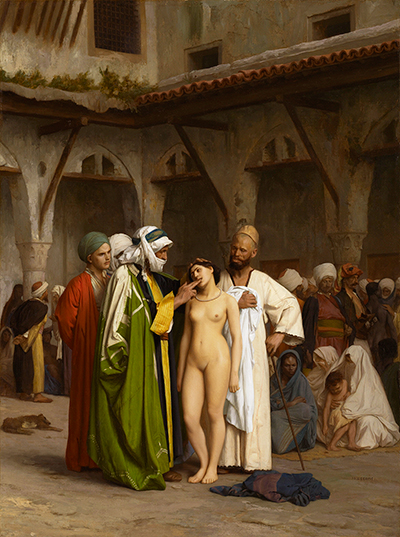Jean-Leon completed this painting in the year 1866 and it remains one of his most provocative works. He still remains among the most influential Orientalist painters to date, renowned for creating paintings that were highly realistic and precisely rendered.
Location and Setting
A quick glance and a viewer will be able to see that the obvious setting of this painting is at the market place in a Near East Country. The idea to come up with this painting probably came to Jean-Leon when he spent some time in during his Near East travels. This was around the same time when slavery was still at its peak. However, it is important to note the depiction of the open air market for slaves did not exist in the mod 19th century thus the only way to view this painting is through idealised depiction.
Techniques and Approaches
It is evident that Jean-Leon put a great deal of time into the painting to achieve that kind of detailing in the painting. This can be seen on the costumes the traders are wearing in the foreground plus the detailing in the surrounding architecture. Furthermore, the artist was able to ensure that the subjects in the background were not absorbed by specifically depicting the clothes they are wearing through contrast with the surrounding buildings.
He was able to explore different themes while creating the painting including Orientalism and motifs inspired by non-European cultures. Through this, he was able to effectively evoke eroticism, passion, danger and primitivism. His technique was able to ensure that his subjects in the painting were eroticized, especially the slave girls using Orientalism as the locus of sensuality, savagery, mystery and decadence. Such a technique gives a viewer the chance to condemn the savage trade by humans but also give them a chance to fantasise over the slave girls. A risqué mix of lust and pity.
Inspirations and Influences
Some of the artists who played a pivotal role in moulding Jean-Leon’s painting career were the likes of Frédéric Auguste Bartholdi and Jean-Auguste-Dominique Ingres. Other personal contacts that had some influence on him included Charles Gleyre and Paul Delaroche. Art movements like Neoclassicism and Modern Photography also played crucial role in shaping his artistic career. Along the way, he influenced and inspired several artists among them being Jean-Paul Laurens, Jon Swihart and Henri Rousseau. He also greatly inspired Orientalism and Neo-Grec art movements.




